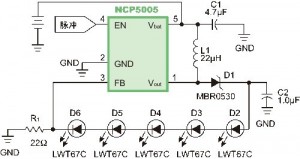The New Requirements of LED Drive Design
A major trend of pushing mobile phone display converted from monochromatic color to colorized color is the integration of the shooting function. At first the imaging device resolution is quite limited, and the image quality is poor. However, with the development of technology, resolution has improved from 300000 pixels VGA level to 1 million level even 2 million pixels, and quickly toward the resolution of the above 3 million pixels level. In imaging devices, processor and the software is improved, consumers want more digital camera functions, such as flash needed in low lighting situation, or even auto focus, etc. In such a resolution, good quality and share pictures and video output becomes more practical, these higher density CMOS imaging devices get more reflects light from target, and thus further promoted the integration of the flash function demand.
If we want the traditional xenon flash placed to a compact cell phones, it is a extremely challenging to design engineer, because in addition to the big flash with a high capacitance outside, we still have to add the light bulb and related transformer and electronic circuits, and the traditional flash also does not apply to video shooting purposes. The good news is, LED manufacturer has already started to adopt gallium nitride indium (InGaN) new material to improve power LED light output.
On the other hand, semiconductor manufacturing technology innovation and improvement of encapsulation methods also raised lumens number and photoelectric conversion efficiency. To produce the highest light output, these power LEDs may need 400 mA or higher, and pulse width in 50 to 200 ms of current output capacity. But for the video applications, it needs smaller current, but the time is not limited to a single pulse. In addition to size restriction and the human engineering, these camera modules usually integrated behind or above the screen, so that users can use LCD as grab image viewfinder, this phone in folding is particularly common. Imaging devices and lens institutions may also be able to rotate, so that cell phones can be used as the tool for face to face communication mode in video meeting, the 3G network in the phone design plan will more widespread, because enough bandwidth can be used on a video conference.
In discussing these trends, we can clearly see that, the quality of the screen and resolution become higher and higher, and size is also bigger and bigger, especially mobile phone with abundant multimedia function, it is estimated that in the future there will be more and more content, such as flow video or radio video, Internet browsing and email, taking pictures and photo view, and game and acquisition of information services, etc. Therefore, the phone screen will be more frequently used when there’s no call, but if the battery life is not enough, these functions will be limited. Therefore, high efficiency of the system power management, including screen and buttons back light power management will become quite important, cameras and flash which only seen in the high-end phones will gradually become standard configuration.
These will also bring challenge to white light LED backlighting driving circuit design: the bigger screen represents more areas needed backlight, so we must improve the overall efficiency of the driving device; Because the space is limited, it must integrate more functions in a single package; Owing to considering not only the size, the thickness must also be cut down, especially sliding and folding modeling product.

